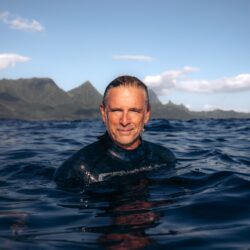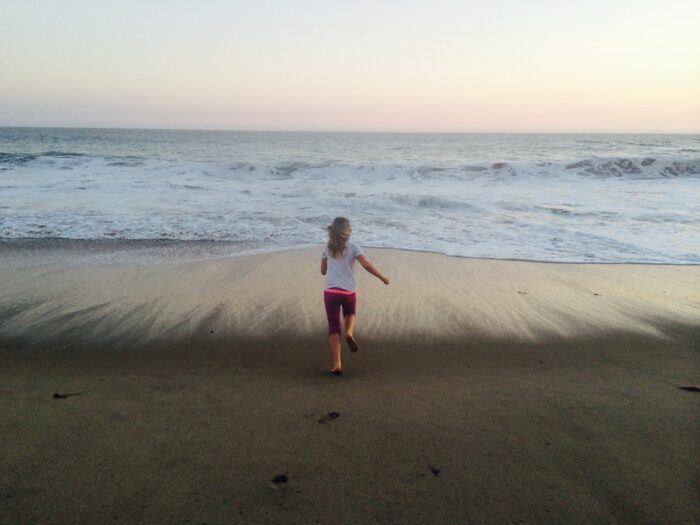
Mental Health Awareness Month: The Benefits of a “Blue Mind”

Written by: Dr. Wallace J. Nichols, author of “Blue Mind – The Surprising Science That Shows How Being Near, In, On or Under Water Can Make You Happier, Healthier, More Connected, and Better at What You Do” and Monterey Bay National Marine Sanctuary Foundation chapter Ambassador
How is your work connected to national marine sanctuaries?
Our National Marine Sanctuaries protect the economic and ecological value of our coasts, oceans and waterways. But they also safeguard vast emotional health benefits. That part of the story is often overlooked…but together we are changing that by making Blue Mind common knowledge and practice, accessible to everyone.
The team at the National Marine Sanctuary Foundation is an important partner in that mission.
How has a “Blue Mind” mindstate and experiences in, around, and on the water helped support your mental health journey?
Like most people, I’ve been through a lot of challenges in the 2020’s so far. We all experienced the losses, uncertainty and confusion of the global pandemic. There are associated economic and political stressors, as well as violence and unrest around the world. Of course bad news about the environment adds to the anxiety we feel, especially for those whose life’s work is connected to nature.
On top of that, our family experienced a catastrophic loss of our home and possessions to wildfire. So, you could say I put Blue Mind to the test in my own life.
Left unchecked the “red mind” stress of modern life can turn into “gray mind” burnout. A regular Bluescription of daily water time, in any form, has really been helpful. Even when I’m not near an ocean or body of water, I practice Blue Mind.
What is the science behind the psychological benefits of a “Blue Mind”? How does being near, in, on, or under water help make us happier, healthier, more connected, and better at what we do?

Photo credit: Wallace J Nichols
Over the past decade Blue Mind Science has exploded. The research is clear that time spent near, in, on or under water in any form (as long as it’s healthy) is good for our cognitive, emotional, psychological, social, physical and spiritual wellbeing. Practicing Blue Mind shifts us into a mildly meditative state, reduces stress, calms our mind, boosts creativity and is one of the best sources of awe and wonder, which builds empathy, resilience, and promote pro-social behaviors. Head over to Google Scholar and search for “blue mind” or “blue health” and dive into the literature!
What are some ways we can tap into the benefits of “Blue Mind” when we aren’t near the ocean or coasts?
Never fear, there are seven forms of Blue Mind so you can get in your 23 minutes a day no matter where you are.
Wild Blue Mind: lakes, rivers, oceans, rain, waterfalls, ponds, ice, snow, etc.
Domestic Blue Mind: pools, tubs, showers, sprinklers, cold plunges and even your sink
Urban Blue Mind: public waterfronts and fountains around your town or city
Virtual Blue Mind: artworks, photography, film, sculpture, prose, poetry, music, recording of water, VR/AR, or any other physical depiction of water where water isn’t present
Imaginary Blue Mind: formed of the multi-sensory memories and nostalgia for any form of water, easily conjured up by our powerful imaginations
Embodied Blue Mind: water is the basis of all life on Earth–we are mostly water, as is all life, animals and plants—from the food we consume to the forests and gardens we visit.
Metaphorical Blue Mind: water is the greatest source of metaphors among our languages and these verbal cues provide a subtle and useful sense of Blue Mind.
I love walking people through the seven forms of Blue Mind to create a personal Bluescription that can be used as a guide to practice Blue Mind daily, wherever they are.
Our preferences, skills and needs change throughout the seven ages of our lives — from birth, through childhood, the middle ages of our lives, and as we age and at the end of life — so we can adjust accordingly. For example, there’s usually a lot more play around water in our younger years, as we get older we may rely on water therapeutically to carry on through physical and emotional changes, and at the end of life the water is the best place to grieve, mourn, and memorialize those we’ve loved and lost.
How does the concept of a “Blue Mind” help us create a sense of sanctuary within ourselves?
It makes perfect sense that a daily Blue Mind practice would work wonders. Once it becomes a habit, it’s second nature. It’s our home. It’s our refuge and sanctuary from an increasingly red-minded world. Thankfully, technology still doesn’t like water that much, so a Blue Mind practice can be a needed source of privacy, quiet and solitude in a world of constant stimulation, monitoring and surveillance.
I meet lots of people at the water’s edge, on boats or boards who are celebrating a milestone, holding a ceremony, or remembering someone special. That’s true sanctuary.
And (how) does that have a reciprocal effect on the protection of our waters?
Our water/ocean value equation is broken. History is clear that when we undervalue anyone or anything, bad things happen. That includes ourselves, each other, and the nature around us that we depend on.

Photo credit: Wallace J Nichols
But when we update that value equation to include the Blue Mind benefits of healthy, thriving waters, backed by rigorous science and economic analysis as well as every wisdom tradition and sacred text, it favors more protection and restoration. It also builds a more diverse and inclusive blue movement. And the conversation begins to include healthy oceans, lakes, and rivers as a healing therapeutic for nurses, teachers, and first responders who work in service of our society every day and are facing burnout. When we take care of our sanctuaries, they can take care of us. And they remain healthy homes to the diversity of plants and animals we share them with. The result, as we’ve seen, is a regenerative and restorative feedback loop that’s good for environmental and human health. We are beginning to tell a more complete and complex water story.
Some sanctuaries are far from human populations and rarely visited, while others are at our doorstep. Monterey Bay National Marine Sanctuary is vast and at one edge of it where it meets the land you’ll find people doing surf therapy, adaptive sailing, ocean programs for kids who are on the autism spectrum, addiction recovery programs, veterans and first responders groups healing their PTSD and participating in service projects. Not to mention the regular stressed-out person getting through their day by taking in the wonder of a sunset behind whale spouts.
Our treasured waters face a number of threats from a changing climate, biodiversity loss, and systemic inequity. Why is it especially important for conservationists to cultivate a “Blue Mind” mindset for self-care and to mitigate or avoid burnout, climate anxiety, etc.?
Most of my colleagues face serious burnout, even the younger ones. If you keep up to date on the research, it’s a daily dose of bad news. If you’re not very thick-skinned it can make you mad, frustrated, angry, sad, afraid or all of the above. None of us can sustain that. And in that red/gray mind state we are certainly not at our best as problem solvers. So, it’s important we have some kind of practice that keeps us calm, creative, compassionate, collaborative and courageous. I haven’t found anything that works better than Blue Mind, with music and a pet coming in a close second and third.
If you combine all three, by playing or listing to music by the water with your furry friend, that’s the best.
What is your favorite memory at a national marine sanctuary or in the ocean?
Being at the beach in the evening for sunset after a day in the water, watching the wildlife and exploring the tide pools, or doing a beach cleanup. A small campfire in the designated fire ring. Our dog George and our kids. It’s the best medicine.

Photo credit: Wallace J Nichols
